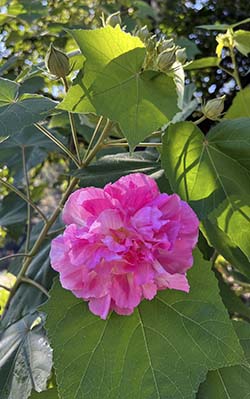
Confederate roses can be rooted over the winter
Now that the summer growing season is over and the temperatures are getting a bit cooler, it’s time to look toward next year’s gardening. It’s never too early to prepare and here are some key chores to do this month.
- Clean up your vegetable gardens and raised beds. Remove dead and dying plants, turn the soil, add organic matter and put the garden to bed for the winter.
- Collect leaves from your yard, shred them or run them over with a mulching lawn mower and add them to your compost pile or put a layer of them directly in your garden beds. You can also use them to mulch around tender perennials and shrubs.
- Repair garden fencing and raise-bed repairs while it’s cooler.
- Consider purchasing the new corrugated garden beds that are gaining popularity. Place them in spots that get 6 to 8 hours of direct sunlight. Go ahead and fill them with soil – a combination of bagged garden soil, organic matter, shredded leaves from your yard and compost. Add some 10-10-10 fertilizer according to the instructions on the bag. You can top them with a double layer of newspaper and mulch to hold the paper in place and you’ll be ready to plant in them come spring.
- Prune back fruiting ramblers, such as blackberries and raspberries. Remove suckers, which can be replanted in the same bed or used to propagate more plants.
- Divide daylilies and other perennials, if you haven’t done so in the past 4 to 5 years. When the clumps get too large, they can stop producing flowers. Find new beds for the extras, or share them with friends to plant in the fall.
- Take semi-ripe and hardwood cuttings of your favorite outdoor plants to propagate. Confederate roses, dinner-plant hibiscus, angel trumpets, gardenias and various types of hydrangeas can be rooted over the winter. You can use a combination of vermiculite and peat moss, but last year with my seed starting I tried a new product, PittMoss, www.pittmoss.com. It worked great, holds moisture, is organic and weed-free, creating a good environment to use for starting stem cuttings. I also use a powered or liquid rooting medium according to package instructions for some of the hardwood cuttings.
- Mulch your gardens and landscape for winter to protect the plants’ roots from harsh temperatures.
- Collect hoses, sprinklers, timers on faucets and other irrigation aids; drain the water from them and store them in a protected place.
- Color for now: Plant pansies in clumps for greater impact this winter. Protect them from grazing deer by either using a deterrent spray like Liquid Fence or Hinder, or covering them with mesh netting or chicken-wire cloches.
- Color for later: Fall is the ideal time to plant bulbs, and cheery daffodils are the most rewarding. They’re deer-proof, they multiply year after year, and you can pick them to make sweet bouquets in the spring.
Photo: by Pamela A. Keene





